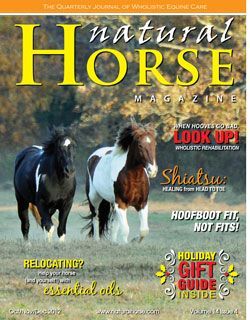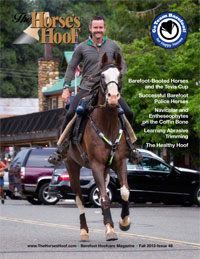This is the 2nd most common time of the year for many horses and ponies to ‘go laminitic’. While there are many causes for laminitis the major one seems to be food/metabolic related.
Homeopathically speaking, there are a number of different remedies that might help your horse. The horse must be treated uniquely – a remedy that might be helpful to one horse may render no results at all for the next.
Homeopathy is based on “like treats like” meaning the individual’s peculiar symptoms are the ones that will dictate which remedy to use. Even though all laminitis is an inflammation of the laminae, the connective tissue between the coffin bone and the hoof capsule, and every laminitis case presents with very similar ‘symptoms’, each horse’s immune system (vital force) is unique and that is what must be treated in order to produce a ‘cure’. While one can treat the ‘symptoms’, as in allopathic medicine, treating the ‘symptoms’ (i.e. administering an anti-inflammatory to reduce the inflammation of the laminae) will not address the CAUSE of the dis-ease. The ROOT cause is always an imbalance in the animal’s own vital force. By looking at the INDIVIDUAL peculiarities of the individual’s ‘symptoms’ one can determine what remedy best suits that individual.
The following remedies are a few of those listed in “Homeopathy for Horses” by Tim Couzens, BVetMed, MRCVS, VetMFHom, CertVetAc:
For all ACUTE cases:
Aconite 1M: Aconite should be used routinely in all acute laminitic cases whatever the cause. This remedy is also useful where stress is a factor.
Dose: every 20 – 30 minustes until the preiod of risk has passed.
Belladonna 1M: Add Belladonna to all cases where there is an increase in the force and rate of the digital pulse however slight. Clear indiciations include an increase in pulse (described as pounding) and respiratory rate, sweating, pain (with the horse leaning back with the weight on the heels), heat in the foot and coronary band and in some cases injected (intensely red) mucous membranes. Belladonna can be used alongside or alternated with Aconite.
Dose: every 20 – 30 minutes until the period of risk has passed.
Secale 200C: Secale is an important remedy in that it will increase the blood flow to the laminae where this has been compromised. It shoudl be given to all acute cases in an attempt to stop laminar separation and pedal bone rotation. The earlier this remedy can be given the better.
Dose: every two or three hourse, reducing to three times daily as symptoms ease.
Also consider:
Hypericum 1M: Hypericum should be added where there is an marked degree of pain and the horse is in a lot of discomfort, barely able to ove or leaning back heavily, shifting weight onto the heels with the front legs well forward.
Dose: Every two to three hours, reducing to three time daily as symptoms ease.
Kali carb 200C: The keynote of this remedy is weakness. It is best reserved for those cases that no only have this symptom but which also show extreme pain with inablility to move more than a short distance. It is also indicated where there is rapid rotation of the pedal bone. Do not use this remedy where there is toxemia or a septic focus.
Dose: every two or three hours, reducing to three times daily as symptoms ease.
Where trauma is involved:
Arnica 200C: Use is all cases of traumatic laminitis whatever the cause.
Dose: every two hours until the period of risk has passed.
Where there is toxemia:
Pyrogen 1M: This is the prinicpal remedy to use where there is a toxic or septic focus. Particular indications include metritis, septic wounds and abscesses.
Dose: every two hours until the period of risk has passed or the symptoms have abated.
Baptisa 200C: This remedy has similar indications to Pyrogen but is indicated where there is prostration and all movement are difficult, as the muscles appear sore.
Dose: every hour until the period of risk has passed or the symptoms have abated.
Where there are dietary causes:
Nux vomica 200c: Nux will drain toxins from the system and help restore balance to the digestive system. It will also act as a general tonic to the liver.
Dose: every two hours until the period of risk has passed.
Lycopodium 1M: Lyco is used in a similar fashion to Nux but is ideally suited to those horses where overeating has also led to gaseous distension or flatulent colic. Lyco wil also help rstore liver function where this has been impaired by the accumulation of toxins. Acute laminitic ases where there is a history of liver disease should be given Lyco routinely.
Dose: every two hours until the period of risk has passed.
Drug-induced Laminitis:
The use of the druge in postency will help. Cortisone 200C or Prednisone 200c can be given three times daily where this has been the initiating cause.
———————————————————-
The BEST medicine is preventative. The more ‘naturally’ you can feed and care for your horse the healthier he/she may be. Start with the diet … Lisa St. John has a Natural Nutrition Therapy that is highly successful with healing metabolic and dietary insults. You can view her webpage here: http://www.lavendersageequine.com
Lisa will be teaching an online course on Equine Natural Nutrition therapy at http://www.horsecourses.net beginning tonight, October 7th at 8 pm Eastern Std. Time. Please go to the PENZANCE Equine Educational Center online to register.











On the remedies for acute, you say “…until the period of risk has passed”. I’m thinking that means until the sugars in the grasses go down…which could take a few weeks. Do you mean to continue those 1M doses for that long? Same question for Nux. That seems like alot.
Yes, it does seem like alot but it depends on the individual’s constitution — these instructions are for the otherwise healthy horse experiencing an acute insult. In acute situations high potencies are generally indicated.
This info was obtained from “Homeopathy for Horses” by Tim Couzens, BVetMed, MRCVS, VetMFHom, CertVetAc: And I think he meant the ‘risk’ to be determined by the horse’s own symptoms. Once the acute symptoms subside then the remedy can be stopped. It has nothing to do with the grass or environmental ‘risks’ … just the symptoms being displayed by the individual horse. Make sense?